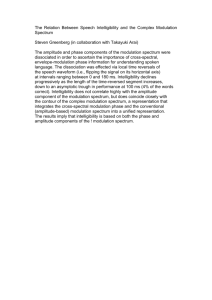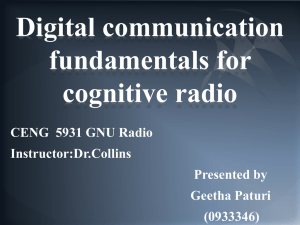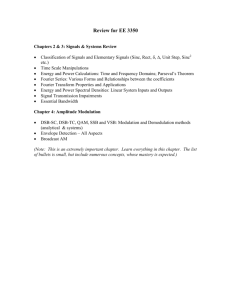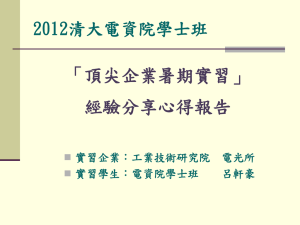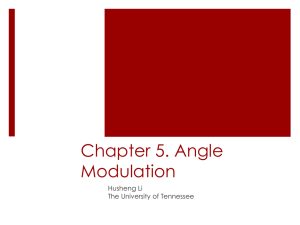Transmission Techniques for Wireless LANs - CWINS
advertisement
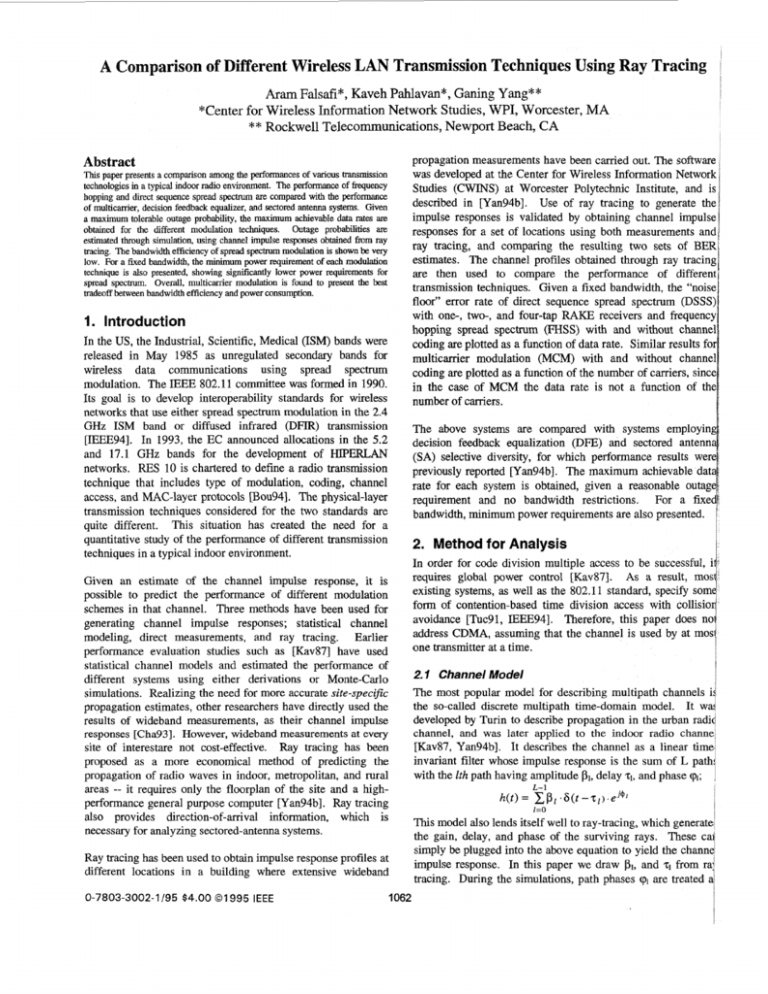
A Comparison of Different Wireless LAN Transmission Techniques Using Ray Tracing
Arm Fah&*, Kaveh Pahlavan”, Ganing Yang**
*Center for Wireless Information Network Studies, WPI, Worcester, MA
* * Rockwell Telecommunications, Newport Beach, CA
Abstract
This paper presents a comparison among the performances of various transmission
technologies in a typical indoor radio environment. The performance of fresuency
hopping and direct sequence spread spectrum are compared with the performance
of multicarrier, decision feedback equalizer, and sectored antenna systems. Given
a maximum tolerable outage probability, the m a x i ” achievable data rates are
obtained for the different modulation techniques. Outage probabilities are
estimated through simulation, using channel impulse responses obtained from ray
uacing. The bandwidth efficiency of spread spectrum modulation is shown be very
low. For a fixed bandwidth, the minimum power requirement of each modulation
technique is also presented, showing significantly lower power xqukments for
spread spectrum. Overall, multicarrier modulation is found to present the best
tradeoff between bandwidth efficiency and power consumption.
1. Introduction
In the US, the Industrial, Scientific, Medical (ISM) bands were
released in May 1985 as unregulated secondary bands for
wireless data communications using spread spectrum
modulation. The IEEE 802.11 committee was formed in 1990.
Its goal is to develop interoperability standards for wireless
networks that use either spread spectrum modulation in the 2.4
GHz ISM band or diffused infrared (DFIR) transmission
[IEEE94]. In 1993, the EC announced allocations in the 5.2
and 17.1 GHz bands for the development of HIPERLAN
networks. RES 10 is chartered to define a radio transmission
technique that includes type of modulation, coding, channel
access, and MAC-layer protocols (Bou941. The physical-layer
transmission techniques considered for the two standards are
quite different. This situation has created the need for a
quantitative study of the performance of different transmission
techniques in a typical indoor environment.
Given an estimate of the channel impulse response, it is
possible to predict the performance of different modulation
schemes in that channel. Three methods have been used for
generating channel impulse responses; statistical channel
modeling, direct measurements, and ray tracing. Earlier
performance evaluation studies such as [Kav87] have used
statistical channel models and estimated the performance of
different systems using either derivations or Monte-Carlo
simulations. Realizing the need for more accurate site-specific
propagation estimates, other researchers have directly used the
results of wideband measurements, as their channel impulse
responses [Cha93]. However, wideband measurements at every
site of interestare not cost-effective. Ray tracing has been
proposed as a more economical method of predicting the
propagation of radio waves in indoor, metropolitan, and rural
areas -- it requires only the floorplan of the site and a highperformance general purpose computer [Yan94b]. Ray tracing
also provides direction-of-arrival information, which is
necessary for analyzing sectored-antenna systems.
propagation measurements have been carried out. The software
was developed at the Center for Wireless Information Network
Studies (CWINS) at Worcester Polytechnic Institute, and is
described in [Yan94b]. Use of ray tracing to generate the
impulse responses is validated by obtaining channel impulse
responses for a set of locations using both measurements and
ray tracing, and comparing the resulting two sets of BER
estimates. The channel profiles obtained through ray tracing
are then used to compare the performance of different
transmission techniques. Given a fixed bandwidth, the “noise
floor” error rate of direct sequence spread spectrum (DSSS)
with one-, two-, and four-tap RAKE receivers and frequency
hopping spread spectrum (FHSS) with and without channel
coding are plotted as a function of data rate. Similar results for
multicarrier modulation (MCM) with and without channel
coding are plotted as a function of the number of carriers, since
in the case of MCM the data rate is not a function of the
number of carriers.
The above systems are compared with systems employing
decision feedback equalization ( D E ) and sectored antenna
(SA) selective diversity, for which performance results were
previously reported [Yan94b]. The maximum achievable data
rate for each system is obtained, given a reasonable outage
requirement and no bandwidth restrictions. For a fixed
bandwidth, minimum power requirements are also presented.
2. Method for Analysis
Ray tracing has been used to obtain impulse response profiles at
different locations in a building where extensive wideband
0-7803-3002-1/95
$4.000 1 995 IEEE
tel
In order for code division multiple access to be successful, i
requires global power control [Kav87]. As a result, mos
existing systems, as well as the 802.11 standard, specify som
form of contention-based time division access with collisio
avoidance [Tuc91, IEEE941. Therefore, this paper does no
address CDMA, assuming that the channel is used by at mos
one transmitter at a time.
1062
1
1
2.1 Channel Model
The most popular model for describing multipath channels id
the so-called discrete multipath time-domain model. It w aI
developed by Turin to describe propagation in the urban radid
channel, and was later applied to the indoor radio channel
tKav87, Yan94bl. It describes the channel as a linear time]
invariant filter whose impulse response is the sum of L path1
with the Zth path having amplitude PI, delay q,and phase 91;
xPl . 6 ( t - z l ) e’@,
1
L-1
h(t) =
I=O
I
I
This model also lends itself well to ray-tracing, which generate1
the gain, delay, and phase of the surviving rays. These ca(
simply be plugged into the above equation to yield the channel
impulse response. In this paper we draw PI, and zI from raj
tracing. During the simulations, path phases (pI are treated
4
random variables uniformly distributed in [0,2n], simulating
small-scale movements of the transmitter and/or receiver, or
motion of objects close to either unit.
2.2 System Descriptions
We examine five transmission techniques in this paper: DSSS,
FHSS, MCM, DFE, and SA. QPSK modulation and coherent
detection are assumed. At the transmitter, data is modulated
onto the I and Q channels of a carrier. The signal is then
passed through the spread spectrum or multicarrier modulator,
and transmitted over the channel, where it is distorted by the
channel multipath characteristics and AWGN. At the receiver,
the signal is demodulated, despread (if applicable), and
sampled at the time determined by the timing recovery circuit.
The resulting decision variable is phase-compensated and used
to determine the bits transmitted over the I and Q channels.
Spread Spectrum
The frequency hopping and direct sequence systems were
described in detail in [Fa195]. In FHSS, the transmitter and
receiver pulse-shaping filters, g,(t) and gt(t), are identical with
a square root of raised cosine frequency response. The received
signal is obtained by convolving the transmitter output with the
channel impulse response and adding noise. This is then dehopped and passed through the receiver’s matched filter,
yielding;
L-1
z(tln)=
xbi
. P I . g(t - iT -z
I ) . ej(’’f-*t+4@n)
+ n1 ( t )
i 1=0
where f, is the nth carrier frequency, (bj} is the complex data
sequence, 8, is the phase offset between the FH modulator and
demodulator, nl(t) is the front-end filter’s response to AWGN,
and g(t)=g,(t)*g,(t) is the impulse response of a raised-cosine
pulse shaping filter. Finally, z(t) is sampled and phasecompensated, yielding a decision variable conditioned on hop
carrier n. The sampling time for a raised cosine pulse is
obtained following the practical method derived in [Val87].
Perfect phase recovery was also assumed.
The DSSS system is assumed to have a spreading gain of N and
chip period T, , such that T=N.T, is the bit period. The
receiver filter is matched to the PN sequence, such that
(without multipath), the cross-correlation of the transmitted
signal and the periodic despreading signal has a peak of width
T, centered at zero delay. The despreader’s output is therefore
given by
L-1
z ( f ) = x x b i . P I .R,(t-iT-zl).ei@r + nl ( f )
i 1=0
where Rx(z) is the cross-correlation of the PN sequence. The
RAKE receiver used in the direct sequence system samples z(t)
at the highest peaks, which are detected using a sliding
window. It then phase-compensates the complex sample to
yield the decision variable.
Multicarrier Modulation
The multicarrier system is shown in figure 1. Since a raised
cosine pulse is assumed, error probability expressions -- again
conditioned on carrier number n -- are similar to those for
frequency hopping. However, depending on the frequency
separation between carriers, interference from adjacent carriers
may also need to be taken into account. If the total system
bandwidth and number of carriers are fixed, increasing the
distance between carriers will reduce the amount of interference
from adjacent carriers, at the expense of data rate. Defining the
time-bandwidth product as the product of symbol period T and
frequency separation Aa,a time-bandwidth product of 1.5 was
found to provide sufficient separation between carriers for a
raised-cosine rolloff factor of 0.5. This was used throughout
the simulations cited in this paper. The carriers are assumed to
be equally spaced with the nth carrier given by o, = Q +
(Ao)n. Given reasonable pulse shaping filters, every carrier
will only be interfered with by its two adjacent neighbors. The
received signal on the nth carrier can therefore be written as
z(tltt)=
{C
1
x b i n *g,(t-iT) *h(t)+tt,(t)
i
where
ca
g,(t)
J g, (TI.ej(Am)mq
. g, ( t - z ) . dz
-=a
and bin is the information bit transmitted on carrier n during the
ith symbol interval. Exact expressions for g+l(t) and g.l(t) for a
raised cosine pulse can be found in [Yan94a]; go(t) is
equivalent to g(t) in the frequency hopping system described
above.
DFE and SA Systems
Performance results for decision-feedback equalizer and
sectored antenna systems at this location were first reported in
[Yan94b]. In the case of DFE modems, the overall sampled
impulse response after equalization is used for z(t) [Pah95].
When sectored antennas are used, the channel impulse response
for each antenna sector is modified to take into account the
direction of arrival of each path. This analysis assumed that
the receiver is equipped with a six-sector directional antenna
whose polarizations are vertical. The ith antenna pattern is
defined by the function
2.78
-ni / 3)
sin(
xi Q,
xi
if --Syf<-+-
(v
2.78.(V - ~ i / 3 )
I
3
2
3
2
Q,
otherwise
L O
where gj(v) is the normalized power gain for a ray arriving
from angle U/, and Q, is the antenna’s 3dB beam width, which
is set to d 3 , resulting in a six-sector antenna. The pattern for
one sector of this antenna is depicted in figure 2. The channel
impulse response for the ith sidelobe is therefore given by
L-1
hi(t)--
cpl.6(t-z1).ej2@’.gi(U/[)
l=O
where ylis the angle of arrival of the lth path.
2.3 Error Rate Analysis
Since QPSK modulation with coherent detection is assumed,
error probability for the I and Q channels can be computed
separately, and combined to arrive at a symbol error rate. The
same equations used for spread spectrum in [Fa1951 are
repeated for MCM, DFE, and SA systems. The receiver's
front-end noise was computed following the derivation in
[Lee891; at an operating temperature of 290"K, thermal noise
will be -174 dBm/Hz. In the case of direct sequence spread
spectrum, the bandwidth of the front-end filter is 25 M H z ,
resulting in noise variance of about -100 a m . In frequency
hopping and multicarrier modulation, the front-end filter's
bandwidth is dependent on the data rate, resulting in a higher
noise variance at higher data rates (lower number of carriers).
In this paper we also study the effect of Reed-Solomon coding,
when used in conjunction with frequency hopping or
multicarrier modulation. If the encoder is an (n, k) coder
defined over G(2*), it is capable of correcting up to (n-k)/2
errors [Pah95]. The number of bits per channel symbol is set
equal to the number of carriers, and each bit of the resulting
codeword is transmitted via a different carrier. The I and Q
channels also carry bits from different codewords. The
probability of codeword error is equal to the probability of
having more than t bits in error. In this study, since the ray
tracing program predicted the error probability of each channel
separately, it was possible to use a more advanced technique to
arrive at more accurate results. As described previously
[Fa195], we follow the procedure presented in Appendix A of
[Pur89]. We also assume that if a codeword is received in
error, half of the decoded information bits will be in error.
2.4 Validation of Ray Tracing Method
From the perspective of system design -- and deployment -- the
requirement is that impulse responses generated via ray tracing
and those obtained from wideband measurements result in
similar performance estimates for the transmission techniques
under study. In [Fa195], channel impulse responses obtained
from measurements and ray tracing were used to obtain error
and outage probabilities for the same set of transmitterheceiver
locations. It was shown that similar performance results are
obtained from either set of impulse responses.
3. Results & Discussion
It is often desirable to view a data channel as odoff, where
outage is defined as the bit error rate exceeding a certain
threshold [Yan94b]. Outage probability can then be defined as
the percent of time that a given location is in outage or the
percent of locations that are in outage at a given time. The
former is often used to describe time-varying channels such as
urban mobile, while the latter is used to describe fixed
installations such as indoor wireless LANs. In this study, an
outage threshold of
was chosen. In this building, 100 mW
of transmitted power (100 mW per carrier in the case of
multicarrier systems) was found to eliminate the effects of
additive noise for all three modulation techniques [Fa195]. It
was therefore chosen as the noise floor power level.
3. I Spread Spectrum
When combined with a RAKE receiver [Pah95], direct
sequence spread spectrum provides sufficient resolution to
allow individual paths to be extracted from the received signal,
providing a form of time diversity. Frequency hopping spread
spectrum, on the other hand, takes advantage of the fact that
different portions of the spectrum tend to fade independently.
Significant improvements can be achieved with a small
reduction in data rate through the use of channel coding and
interleaving, as described in the previous section.
Assuming QPSK modulation in a fixed bandwidth of 25 MHz,
processing gains of 7, 15, 31, and 63 result in uncoded data
rates of 7.1, 3.3, 1.6, and 0.79 MBPS, respectively. When
channel coding is used, Reed-Solomon codes of ( 7 3 , (15,11),
(31,23), and (63,45) are used, so that in all cases the reduction
in data rate is approximately a factor of 5/7. The resulting data
rates are 5.1,2.4, 1.2, and 0.57 MBPS for the FHSS system.
Figure 3 is a plot of outage probability vs. data rate for
frequency hopping spread spectrum with and without ReedSolomon coding and direct sequence spread spectrum with 1-,
2-, and 4-tap RAKE receivers employing maximal ratio
combining. It can be seen that with a four-tap RAKE receiver,
DSSS performs better than FHSS without coding. However,
when coding is added to frequency hopping spread spectrum,
its performance improves significantly; the error rate falls to
practically zero with only 15 carriers.
3.2 Multicarrier Modulation
Using multicarrier modulation with a time-bandwidth product
of 1.5, a system bandwidth of 25 MHz, and QPSK modulation
resulted in a data rate of 33.3 MBPS. With coding, the data
rate was reduced to 24 MBPS. Figure 4 shows the outage rate
of multicarrier systems with and without channel coding, as a
function of number of carriers (since the data rate was
essentially constant).
Comparing these results with those of the previous section, it is
obvious that in a bandlimited system that does not implement
code division multiple access, for a given bit error rate,
multicarrier modulation allows a higher data rate than either
form of spread spectrum modulation. Furthermore, since it is
obvious from figure 4 that the outage probability can be reduced
by increasing the number of carriers, multicarrier modulation
offers the potential of lowering the outage probability without a
corresponding reduction in the data rate.
3.3 A ComparisonAmong Transmission Techniques
Table II of [Yan94b] presents the maximum data rates that can
be achieved with DFE, SA, and DFE/SA systems, given an
outage probability of .01 and assuming unlimited available
bandwidth. Since these results were for BPSK modulation, the
data rates were doubled to reflect the increased data rate
achievable with QPSK modulation and perfect phase recovery.
These numbers assumed no limit on the available bandwidth.
Therefore, comparable results were obtained for the spread
spectrum systems by repeating the simulations at different
system bandwidths with the processing gain fixed. The results
have been summarized in figure 5. Results for multicarrier
modulation have not been presented, because (given no
bandwidth limitations) the data rate of multicarrier systems is
1064
I
infinite; the restriction in this case is the complexity of the
system. To have outage rates of .01 or less, spread spectrum
appears to only allow data rates of betwetn 1 and 10 MBPS,
even with no limits on the available bandwidth.
Based on the above discussion, it may appear that spread
spectrum modulation is not a suitable transmission technique
for wireless data networks. However, bandwidth efficiency is
only one side of the equation; the processing gain that spread
spectrum provides can serve to increase the fade margin,
reducing the transmitter’s power requirement. This could be
an important consideration if the wireless network is being used
to connect portable, battery-operated computers. Using the
same outage criterion as above, the minimum power
requirement of spread spectrum modulation was compared to
that of MCM, DFE, and sectored antenna systems. Figure 6
shows the minimum power required to achieve an outage rate
of .01 for DSSS with 4 taps, as well as FHSS and MCM with
and without Reed-Solomon coding. Also presented are the
power requirements to achieve the same outage probability
using DFE, SA, and DFE/SA systems. A total system
bandwidth of 10 MHz is assumed. According to this figure,
spread spectrum can add between 30 and 35 dB to the fade
margin. Furthermore, equalization itself is a power-intensive
operation, a significant factor for portable, battery-operated
computers. On the other hand, it can be expected that wireless
networks that serve mostly portable users will operate at lower
power levels with much smaller cells -- especially if significant
processing gain is available. This will result in better
frequency reuse, partially canceling the bandwidth inefficiency
of spread spectrum modulation.
The power savings possible with spread spectrum modulation
can only be achieved at the expense of data rate. On the other
hand, multicarrier modulation can provide an improvement of
about 20-25 dB, with only a small reduction in the data rate.
As a result, in systems where both bandwidth efficiency and
power consumption are important, multicarrier modulation can
provide the best tradeoff.
4. Summary and Conclusions
Different transmission techniques have been presented, and
compared using channel impulse responses generated by a ray
tracing algorithm. Outage probability was plotted as a function
of data rate for spread spectrum systems with different levels of
system complexity and as a function of number of carriers for
multicarrier modulation. These were compared with DFE, SA,
and DFEISA systems.
It was shown that spread spectrum is not an efficient way of
combating multipath fading in an indoor environment; the loss
in bandwidth efficiency is too high in a “large” LAN
environment where throughput is a critical factor. On the other
hand, in networks where users have battery-operated portable
:omputers, due to smaller cell size and better frequency reuse,
bandwidth efficiency requirements may not be as strict, making
spread spectrum modulation more attractive due to its
xocessing gain (which further reduces the power
requirements). If both bandwidth efficiency and power
consumption are important, multicarrier modulation appears to
present the best tradeoff.
References
[Bou94] B. Bourin, “HIPERLAN - Markets and Applications
Standardisation Issues”, IEEE Int’l. Conf. on Personal, Indoor,
and Mobile Radio Communications, Hague, Netherlands, Pp.
863-868, Sept. 1994.
[Cha93] M. Chase, K. Pahlavan, “Performance of DS-CDMA
Over Measured Indoor Radio Channels Using Random
Orthogonal Codes”, IEEE Trans. on Vehicular Technology,
Vol. 42, Pp. 617-624, NOV.1993.
[Fa1951 A. Falsafi, K. Pahlavan, “A Comparison Between the
Performance of FHSS and DSSS for Wireless LANs Using a
3D Ray Tracing Program”, IEEE Vehicular Technology
Conference, Chicago, IL, July 1995.
[IEEE94] IEEE Std. 802.11-93/20b3, “Wireless LAN Medium
Access Control (MAC) and Physical Layer (PHY)
Specifications”, draft standard, September 1994.
[Kav87] M. Kavehrad, B. Ramamurthi, “Direct Sequence
Spread Spectrum with DPSK Modulation and Diversity for
Indoor Wireless Communications”, IEEE Transactions on
Communications, Vol. 35, Pp. 224-236, February 1987.
[Lee891 W. C. Y. Lee, Mobile Cellular Telecomm. Svstems,
New York, McGraw-Hill, 1989.
[Pah95] K. Pahlavan, A. Levesque, Wireless Information
Networks, John Wiley, 1995.
[Pur891 M. Pursley, S. Sandberg, “Variable-rate Coding for
Meteor-burst Communications”, IEEE Transactions on
Communications, Vol. 37, Pp. 1105-1112, Nov. 1989
[Tuc91] B. Tuch, “An ISM Band Spread Spectrum Locan Area
Network: WaveLAN’, IEEE Workshop on Wireless Local Area
Networks, Worcester, MA, Pp. 103-111, May 1991.
[Val871 R. Valenzuela, “Performance of Quadrature Amplitude
Modulation for Indoor Radio Communications”, IEEE Trans.
on Comm., Vol. 35, Pp. 1236-1238, Nov. 1987.
[Yan94a] G. Yang, K. Pahlavan, “Performance Analysis of
Multicarrier Modems in Office Environment Using 3D Ray
Tracing”, IEEE GLOBECOM ‘94 San Francisco, CA, Pp. 4246, November 1994.
[Yan94b] G. Yang, K. Pahlavan, T. Holt, “Sector Antenna and
DFE Modems for High Speed Indoor Radio Communications”,
IEEE Trans. on Vehicular Technology, Vol. 43, Pp. 925-933,
Nov. 1994.
1065
Fii 1- Mnlticanier ModulafjonSystem
Fig.2 - Antenna patternfor ofie sector
Timing
NO'
=.
-bp+,
e.
I
of &-sector a n m a .
D
A
T
A
.
-
-
Fig. 5 Max. data rate, unlimited bandwidth
=::
.
.
.
.
.
Fig. 6 Min. power, lOMHz Total Bandwidth
1066
.
